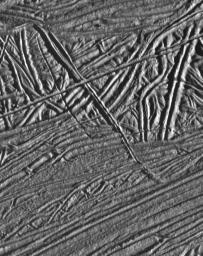
|
Cross-cutting Relationships of Surface Features on Europa
- Click the image above for a larger view
- Full-Res JPEG (950 x 1200) (186.2 kB)
- Full-Res TIFF (950 x 1200) (1.2 MB)
Caption:
This image of Jupiter's moon Europa shows a very complex terrain of ridges and fractures. The absence of large craters and the low number of small craters indicates that this surface is geologically young. The relative ages of the ridges can be determined by using the principle of cross-cutting relationships; i.e. older features are cross-cut by younger features. Using this principle, planetary geologists are able to unravel the sequence of events in this seemingly chaotic terrain to unfold Europa's unique geologic history.
The spacecraft Galileo obtained this image on February 20, 1997. The area covered in this image is approximately 11 miles (18 kilometers) by 8.5 miles (14 kilometers) across, near 15 North, 273 West. North is toward the top of the image, with the sun illuminating from the right.
Background Info:
The Jet Propulsion Laboratory, Pasadena, CA manages the mission for NASA's Office of Space Science, Washington, DC.
This image and other images and data received from Galileo are posted on the World Wide Web, on the Galileo mission home page at URL http://galileo.jpl.nasa.gov. Background information and educational context for the images can be found at http://www.jpl.nasa.gov/galileo/sepo .
Cataloging Keywords:
| Name | Value | Additional Values |
|---|---|---|
| Target | Europa | |
| System | Jupiter | |
| Target Type | Satellite | |
| Mission | Galileo | |
| Instrument Host | Galileo Orbiter | |
| Host Type | Orbiter | |
| Instrument | Solid-State Imaging (SSI) | |
| Detector | ||
| Extra Keywords | Crater, Grayscale | |
| Acquisition Date | ||
| Release Date | 1998-03-26 | |
| Date in Caption | 1997-02-20 | |
| Image Credit | NASA/JPL | |
| Source | photojournal.jpl.nasa.gov/catalog/PIA00851 | |
| Identifier | PIA00851 | |
